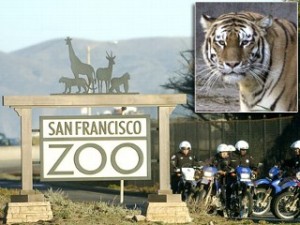San Francisco Zoo Faces Vicious Legal Battle
 Remember Kulbir and Amitpal Dhaliwal – the brothers who allegedly taunted a tiger at the San Francisco Zoo, who then escaped from its enclosure, mauling them and killing one of their friends? Well, the Dhaliwals are back… and they’re suing. The brothers recently filed a lawsuit in federal court against the city and its police department, as well as the zoo and its PR firm. The brothers claim that the tiger’s enclosure did not meet national safety standards and the zoo engaged in a smear campaign against them following the attacks.
Remember Kulbir and Amitpal Dhaliwal – the brothers who allegedly taunted a tiger at the San Francisco Zoo, who then escaped from its enclosure, mauling them and killing one of their friends? Well, the Dhaliwals are back… and they’re suing. The brothers recently filed a lawsuit in federal court against the city and its police department, as well as the zoo and its PR firm. The brothers claim that the tiger’s enclosure did not meet national safety standards and the zoo engaged in a smear campaign against them following the attacks.
What theories will the Dhaliwals pursue? Would strict liability for ultra-dangerous activities apply? Under this theory, some activities are so dangerous that no amount of precautionary measures will insulate a handler from liability. According to precedent from the First District of Appeal, the doctrine is not applicable to a city carrying on government functions, including maintaining a zoo; the city is merely responsible for harm created by a “dangerous or defective condition” on public property that officials should have known about but neglected to fix.
However, according to legal experts this 1952 case may no longer be binding since California has revised its laws regarding suing governmental agencies. Additionally, unlike in 1952, the SF Zoo now charges admission; it therefore owes a greater duty of care toward its guests. Moreover, the zoo is now managed by the San Francisco Zoological Society, a non-profit organization that remains strictly liable under the ultra-hazardous activities doctrine.
The city may try to rely on its contract with the Zoological Society which insulates it from liability unless a city employee is found to be at fault. According to legal analysts, however, it should be pretty easy to show fault given that the zoo director admitted the wall around the tiger fell four feet below national safety regulations, and Tatiana (the tiger) previously attacked a trainer.
What role will the Dhaliwals’ supposed negligence – i.e. taunting – play in the case? Did they “assume the risk”? Probably not. Given how common (and wrong) it is for zoo patrons to tease animals, the zoo should have been aware of the need to contain the tiger in the event that it became aggressive after being provoked.
While some say that suits like this ultimately serve a public safety purpose, I wonder if the legal costs incurred by the zoo in defending against this suit will actually make the place more dangerous. Zoo officials have announced it will impose budget cuts of $700,000, largely related to the suit, and will consequently cut salaries and part-time workers.


Comments